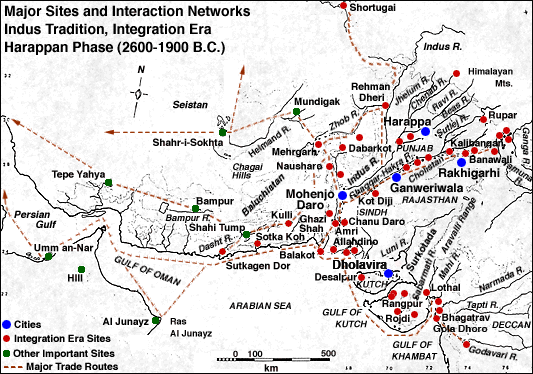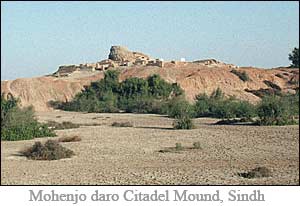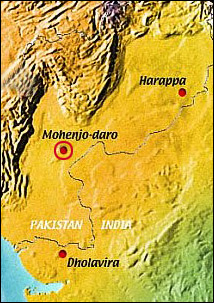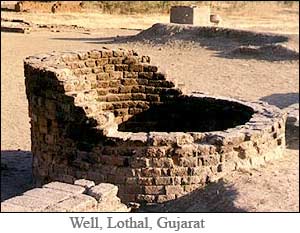
Harappa
Harappa was an Indus civilization urban center. It lies in Punjab Province, Pakistan, on an old bed of the River Ravi.
The latest research has revealed at least five mounds at Harappa that 3-D renditions of Harappa show to have been surrounded by extensive walls. Two mounds have large walls around them, perhaps as much for trade regulation as defense.
A structure once considered a granary is now thought to have been a large building with ventilated air ducts. A set of working platforms to the south of this structure are also of great interest to archaeologists.
An abundance of terracotta figurines at Harappa provided the first clues in the 19th century to the ancient Indus - often abbreviated as Harappan - civilization.
Mohenjo Daro

Mohenjo Daro is probably the best known Indus site. Mohenjo Daro is in Sindh, Pakistan, next to the Indus River, not far from the very early human flint mining quarries at Rohri. The Indus may once have flowed to the west of Mohenjo Daro, but it is now located to the east.
Here the Great Bath, uniform buildings and weights, hidden drains and other hallmarks of the civilization were discovered in the 1920's. This is where the most unicorn seals have been found. Due to a rising water table, most of the site remains unexcavated, and its earliest levels have not been reached.
Dholavira

Dholavira is located on Khadir Beyt, an island in the Great Rann of Kutch in Gujarat State, India. It has only been excavated since 1990. As large as Harappa and Mohenjo Daro, it has some of the best preserved stone architecture.
A tantalizing signboard with Indus script has also been discovered.
Dholaviraappears to have had several large reservoirs, and an elaborate system of drains to collect water from the city walls and house tops to fill these water tanks.

Lothal
Lothal is on the top of the Gulf of Khambat in Gujarat, India, near the Sabarmati River and the Arabian Sea. It is the most extensively researched Harappan coastal site.
A bead factory and Persian Gulf seal have been found here suggesting that, like many sites on the Gulf of Khambat, it was deeply involved in trade.
Rakhigarhi
Rakhigarhi is a recently discovered city in Haryana, India. Partial excavations have revealed that it is as large as Harappa, Mohenjo Daro and Ganweriwala.
Ganweriwala
Ganeriwala is in Punjab, Pakistan near the Indian border. It was first discovered by Sir Aurel Stein and surveyed by Dr. M. R. Mughal in the 1970's. It spreads over 80 hectares and is almost as large as Mohenjo Daro. It is near a dry bed of the former Ghaggar or Sarasvati River, and has not been excavated, yet. Equidistant between Harappa and Mohenjo Daro, Ganweriwala may have been a fifth major urban center.
Smaller Settlements
Gola Dhoro (also known as Bagasara) is a site in Gujarat, India, excavated from 1996 to 2004. A distinctive ancient Indus seal was found there, as well as extensive evidence for the sudden evacuation of this tiny town with well stocked manufacturing facilities.
Daimabad is in Maharashtra near Bombay. Discovered in 1958, it is a controversial site. Some suggest that the pottery and single shard with ancient Indus signs on it is definitive of Harappan settlement; others maintain that the evidence is insufficient. A unique hoard of exquisite bronze chariots and animals that may or may not be of Indus Civilization style was also found here.
Chanhudaro is 80 miles south of Mohenjo Daro in Sindh. It was a manufacturing center. Various tool, shell, bone and seal-making facilities which involved writing were found. Beads were made using efficiently layered floors. Chanhudaro seems also to have been hastily abandoned.
Sutkagen Dor in Baluchistan is the westernmost known Harappan site located on the Pakistani border with Iran. It is thought to have once been on a navigable inlet of the Arabian Sea. The usual citadel and town are present, as well as defensive walls 30 feet wide. Sutkagen Dor would have been on the trade route from Lothal in Gujarat to Mesopotamia and was probably heavily involved in the fishing trade similar to that which exists today in the coast along Baluchistan.
All these sites flourished for various periods between 3500 and 1700 B.C.E. There are probably many more important Indus sites. Some must have been lost or destroyed by shifting river paths. Others are probably buried under modern towns.
What does seem clear is that the important sites were ancient commercial centers. They are on rivers or near the coast. Various specialized manufacturing facilities suggest that they were heavily involved in trade with each other and far outside the region.
